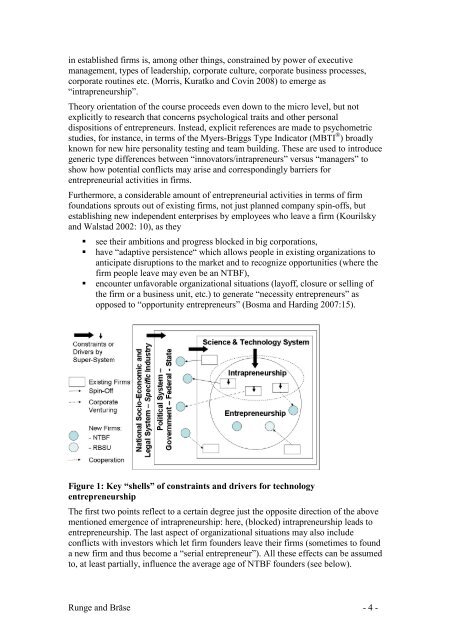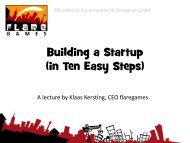Education in Chemical Entrepreneurship - KIT - Technology ...
Education in Chemical Entrepreneurship - KIT - Technology ...
Education in Chemical Entrepreneurship - KIT - Technology ...
Create successful ePaper yourself
Turn your PDF publications into a flip-book with our unique Google optimized e-Paper software.
<strong>in</strong> established firms is, among other th<strong>in</strong>gs, constra<strong>in</strong>ed by power of executive<br />
management, types of leadership, corporate culture, corporate bus<strong>in</strong>ess processes,<br />
corporate rout<strong>in</strong>es etc. (Morris, Kuratko and Cov<strong>in</strong> 2008) to emerge as<br />
“<strong>in</strong>trapreneurship”.<br />
Theory orientation of the course proceeds even down to the micro level, but not<br />
explicitly to research that concerns psychological traits and other personal<br />
dispositions of entrepreneurs. Instead, explicit references are made to psychometric<br />
studies, for <strong>in</strong>stance, <strong>in</strong> terms of the Myers-Briggs Type Indicator (MBTI ® ) broadly<br />
known for new hire personality test<strong>in</strong>g and team build<strong>in</strong>g. These are used to <strong>in</strong>troduce<br />
generic type differences between “<strong>in</strong>novators/<strong>in</strong>trapreneurs” versus “managers” to<br />
show how potential conflicts may arise and correspond<strong>in</strong>gly barriers for<br />
entrepreneurial activities <strong>in</strong> firms.<br />
Furthermore, a considerable amount of entrepreneurial activities <strong>in</strong> terms of firm<br />
foundations sprouts out of exist<strong>in</strong>g firms, not just planned company sp<strong>in</strong>-offs, but<br />
establish<strong>in</strong>g new <strong>in</strong>dependent enterprises by employees who leave a firm (Kourilsky<br />
and Walstad 2002: 10), as they<br />
� see their ambitions and progress blocked <strong>in</strong> big corporations,<br />
� have “adaptive persistence“ which allows people <strong>in</strong> exist<strong>in</strong>g organizations to<br />
anticipate disruptions to the market and to recognize opportunities (where the<br />
firm people leave may even be an NTBF),<br />
� encounter unfavorable organizational situations (layoff, closure or sell<strong>in</strong>g of<br />
the firm or a bus<strong>in</strong>ess unit, etc.) to generate “necessity entrepreneurs” as<br />
opposed to “opportunity entrepreneurs” (Bosma and Hard<strong>in</strong>g 2007:15).<br />
Figure 1: Key “shells” of constra<strong>in</strong>ts and drivers for technology<br />
entrepreneurship<br />
The first two po<strong>in</strong>ts reflect to a certa<strong>in</strong> degree just the opposite direction of the above<br />
mentioned emergence of <strong>in</strong>trapreneurship: here, (blocked) <strong>in</strong>trapreneurship leads to<br />
entrepreneurship. The last aspect of organizational situations may also <strong>in</strong>clude<br />
conflicts with <strong>in</strong>vestors which let firm founders leave their firms (sometimes to found<br />
a new firm and thus become a “serial entrepreneur”). All these effects can be assumed<br />
to, at least partially, <strong>in</strong>fluence the average age of NTBF founders (see below).<br />
Runge and Bräse - 4 -














